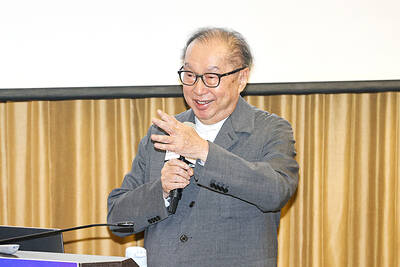Micron Technology Inc chief executive officer Steve Appleton may be about to succeed in his decade-long quest to end the boom-and-bust cycles bedeviling the memory-chip industry.
A joint venture with Nanya Technology Corp (南亞科技) and speculation that Micron may acquire Qimonda AG are signs Appleton, 48, is determined to get hold of enough production to prevent future gluts. Falling prices and a second year of industry sales declines are forcing competitors to band together and making potential acquisitions more affordable.
“You’re starting to see the cracks,” said Hans Mosesmann, an analyst at Raymond James & Associates in New York who rates Micron a “strong buy.”
He projected the shares would double in 12 months to more than US$10.
“A lot of companies in the industry have been hurt,” he said.
Micron, the world’s fourth-largest maker of memory chips, is trying to eliminate rivals and get closer in size to the industry leader, Samsung Electronics Co.
Not counting Samsung, the 10 biggest manufacturers are all losing money. Micron’s six straight quarterly losses, totaling US$1.7 billion, have driven its shares down 29 percent this year.
Micron’s balance sheet gives Appleton buying power. The company’s debt-to-equity ratio of 37 percent compares with an average of 63 percent for rivals excluding Samsung. Micron had US$1.58 billion in cash as of May 29 and US$2.4 billion in long and short-term debt.
“As opportunities come up, we are going to look pretty hard at them,” Appleton told analysts at a meeting last month.
Manufacturers have long failed to match output with demand for the dynamic random access memory, or DRAM, chips used in personal computers.
Prices can seesaw during the period of more than a year that it takes to build plants, which cost more than US$3 billion. Shutdowns are so expensive that assembly lines run night and day, even when the chips sell below production costs.
The average price of DRAM chips has been below US$2 for a year. Under that level the companies lose money, Deutsche Bank analyst Bob Gujavarty said in San Francisco.
Qimonda’s German parent, Infineon Technologies AG, wrote down the unit by 1 billion euros (US$1.39 billion) in April.
The industry won’t regain its health until there are only three major producers, so survivors can eliminate duplicate spending, Appleton said last month.
“Markets like now create opportunities,” he said.
The CEO has already narrowed the field. Micron bought Texas Instruments Inc’s memory business in 1998 and Toshiba Corp’s memory plant in Manassas, Virginia, and Kobe Steel Ltd’s KMT Semiconductor Ltd unit in 2001.
Today, Micron has a 10.9 percent share, behind Samsung, Hynix and Japan’s Elpida Memory Inc.
Micron may buy the assets of No. 5 Qimonda in a distress sale, Cowen & Co analyst Daniel Berenbaum said. Appleton may also be interested in Qimonda’s stake in Inotera Memories Inc (華亞科技), a separate venture with Taiwan’s Nanya.
Acquiring all of those operations would give Micron command of 24 percent of the market, and concentrate 89 percent of industry sales with four producers, data from iSuppli showed.
“He could be right this time,” said Caris & Co analyst Betsy Van Hees in San Francisco. “We’ve never seen such a prolonged and deep trough.”
Besides Samsung, only Micron and Hynix had positive gross margin, or revenue after production costs, in the most recent quarter. Micron also generated more than US$200 million in cash from operations. Taiwan’s Powerchip Semiconductor Corp (力晶半導體) was the only other competitor that produced cash.
Samsung may also be helping to push the industry toward Appleton’s vision of fewer suppliers. The company plans to spend US$6.3 billion this year on semiconductor plants and equipment, making it harder for rivals to keep up.
“They could be trying to price the Taiwanese out of the market,” Van Hees said. “Samsung is putting the pedal to the metal.”

BYPASSING CHINA TARIFFS: In the first five months of this year, Foxconn sent US$4.4bn of iPhones to the US from India, compared with US$3.7bn in the whole of last year Nearly all the iPhones exported by Foxconn Technology Group (富士康科技集團) from India went to the US between March and last month, customs data showed, far above last year’s average of 50 percent and a clear sign of Apple Inc’s efforts to bypass high US tariffs imposed on China. The numbers, being reported by Reuters for the first time, show that Apple has realigned its India exports to almost exclusively serve the US market, when previously the devices were more widely distributed to nations including the Netherlands and the Czech Republic. During March to last month, Foxconn, known as Hon Hai Precision Industry

Taiwan Semiconductor Manufacturing Co (TSMC, 台積電) and the University of Tokyo (UTokyo) yesterday announced the launch of the TSMC-UTokyo Lab to promote advanced semiconductor research, education and talent development. The lab is TSMC’s first laboratory collaboration with a university outside Taiwan, the company said in a statement. The lab would leverage “the extensive knowledge, experience, and creativity” of both institutions, the company said. It is located in the Asano Section of UTokyo’s Hongo, Tokyo, campus and would be managed by UTokyo faculty, guided by directors from UTokyo and TSMC, the company said. TSMC began working with UTokyo in 2019, resulting in 21 research projects,

Ashton Hall’s morning routine involves dunking his head in iced Saratoga Spring Water. For the company that sells the bottled water — Hall’s brand of choice for drinking, brushing his teeth and submerging himself — that is fantastic news. “We’re so thankful to this incredible fitness influencer called Ashton Hall,” Saratoga owner Primo Brands Corp’s CEO Robbert Rietbroek said on an earnings call after Hall’s morning routine video went viral. “He really helped put our brand on the map.” Primo Brands, which was not affiliated with Hall when he made his video, is among the increasing number of companies benefiting from influencer

Quanta Computer Inc (廣達) chairman Barry Lam (林百里) yesterday expressed a downbeat view about the prospects of humanoid robots, given high manufacturing costs and a lack of target customers. Despite rising demand and high expectations for humanoid robots, high research-and-development costs and uncertain profitability remain major concerns, Lam told reporters following the company’s annual shareholders’ meeting in Taoyuan. “Since it seems a bit unworthy to use such high-cost robots to do household chores, I believe robots designed for specific purposes would be more valuable and present a better business opportunity,” Lam said Instead of investing in humanoid robots, Quanta has opted to invest